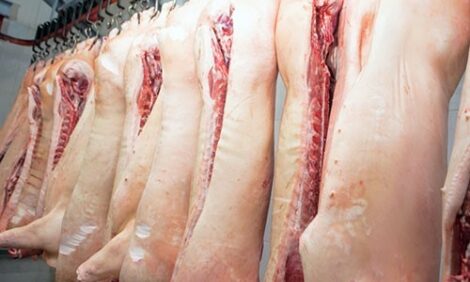



Restock Herds Successfully Using JSR AI
UK - A full herd restock is never a lightly made decision. Demanding forward planning, the ability to withstand a halt in production and to fund the financial input to restock, requires considerable effort and commitment.However, for those considering the strategy, the positive outcome can bring not only a healthier, more productive herd but, along with it, fresh impetus and enthusiasm.
Des Allen of Allen Farms in Newark, Nottinghamshire, who farms with his brother Robert, has over 550 sows on a mixed indoor/outdoor unit. Sows spend most of their time outdoors but half farrow indoors, half outdoors, with all stock finished indoors on straw.
“We have been keeping pigs on this farm for over 50 years,“ says Mr Allen, Chairman of the East Midland Pig Health Scheme, “and slowly, over the years, you pick up different bugs which, once you've got, you never entirely get rid of. We had particular problems with pneumonias and Glässer's Disease caused by the Haemophilus parasuis bacteria. The danger is you start to learn to live with them. But in the end, we were using more medication than we were really comfortable with - and still not getting the performance we needed. It was taking all the enjoyment out of the job.“
A fresh start
The final timing of the destock-repop was financial. “We felt that, with profitability in pigs at what we considered a real low point, we should take the plunge and restock with a healthy herd in time to hit an improved market. Little did we know what would happen to feed and cereal prices,“ says Mr Allen ruefully.
For Mr Allen, a total destock-repop completed in 2011 provided an opportunity to make a new start and focus on improving results. New finishing accommodation, with one building converted and one newly built, has been designed to take a batch of finishers from between 75 and 80 sows in each.
“We were determined to restock with genetics capable of taking the unit forward. We chose JSR Genepacker 120's, 500 of them - which thrive in both outdoor and semi-intensive systems - and use the JSR AI service with the JSR Geneconverter 700 and 750 boar lines to produce lean, vigorous, fast growing piglets. We also have around 50 pure Durocs so we can breed our own Genepacker 120 parent gilts.“
AI and Three week batch farrowing
Sows are served indoors, with the majority of dry sows moving outside. Farrowing, however, alternates between batches farrowing in indoor crates and outside farrowing arks.
“We have always run a three week batch farrowing system,“ says Mr Allen, “so the AI from JSR, gives us the high level of control we need. We find JSR's Semen Delivery System, Coolink, very convenient, reliable and, we can leave a coolbox outside the door. Also it is reassuring to know that JSR perform so many quality checks, inspecting all semen collected for abnormalities. Now that the restock is complete, and it has been six months since we started farrowing, the benefits are really showing. The Genepacker 120s are a much more productive pig, and are consistently 1-1.5 pigs per sow better than our previous herd's performance.“
Checkmate
As part of the JSR service, the Allens were introduced to Checkmate, designed and operated by independent consultant Paul Wright. A weekly monitoring programme, it provides a realistic production target for any facility and pinpoints any areas causing a shortfall.
“We map the unit to measure its potential, then create a plan,“ says Mr Wright. “For Mr Allen, our aim was to serve enough sows to fill his 72 farrowing crates, or if farrowing outside, 72 arks. Using Regumate® on the sows to synchronise oestrus, and JSR AI, they have done extremely well. Each batch so far has been at least 77 sows, producing as many as 894 piglets. He is weaning, on average, 754 pigs. So far it has gone like clockwork.“
Conception rates up to 96 Per Cent
“Working with Checkmate and our vet Guy Wade-West, from Garth Vets, we have got AI down to a fine art,“ agrees Mr Allen. “It gives us the high level of control you need for successful batch farrowing and on average sows and gilts are served at least twice. We've done 11 batches now, and of those there's only been two of 85% conception or less. All the rest have been 90 per cent plus, with one at 96 per cent: before the destock we were getting around 80-85 per cent. This is one aspect that I hadn't really budgeted for being so much better. Now, due to their better health, they come on heat in a very narrow band of time and we have learnt to be very disciplined.“
- Fourth day after weaning - Friday 11 am - check for sows on heat.
- Seven to Eighht hours later AI pigs
- Fifth day - Saturday 1pm - AI every pig on heat
- Sixth day - Sunday morning 9am - AI every pig on heat
- Seventh day - AI remaining pigs on heat twice on Monday
“We had thought that there was no way we could stick to these timings,“ said Des, whose busy farm also has over 800 acres of arable, “but by changing to serving over a weekend, when there are fewer distractions, we have been able to.“
Over 12 born alive
With both indoor and outdoor units, Mr Allen accepts a degree of variance in his productivity figures. “We farrowed our first batches at the end of January and are now averaging over 12 born alive indoors and consistently rear over 10.5 - that's including the gilts. Outside, we can rear 9.75 on one batch, but just under nine on others, so a 1.5 pig difference, which can be very frustrating. I think that, eventually, we will move towards indoor farrowing. In the right conditions, outdoor production can be very enjoyable, and good for marketing, but this year the conditions have never been right - it's been like a 12 month winter!.“
The grower and finisher stage has also seen improvement with a 'very pleasing' figure of just 2-2.5 per cent mortality.
“The destock has given the whole team a new focus,“ says Mr Allen. “Working with these healthier pigs you can really see the results of any effort you make. Before we sometimes felt we were swimming against the tide. Now that we have been able to put new rules and disciplines into place, and are seeing the rewards, the morale of the whole team is high.“








